Drilling
How to drill and develop an oil field in an urban setting
BreitBurn Energy used a novel, award-winning rack & pinion drilling rig in its East Beverly Hills oil field. The West Pico drillsite is located in West Los Angeles in the middle of a busy commercial/ residential sector
Steve Liles, Consultant, Southern California; Ron Tinkham, Tinkham Inc., Solana Beach, California; and Jens P. Røkenes and Bjørn Eilertsen, EDM, Norway
The drillsite was small, but a big challenge. The site was on Pico Boulevard at Doheny Drive, eight miles west of downtown Los Angeles and just one block south of Beverly Hills. It was originally permitted, built and drilled by Occidental Petroleum in the early 1960s, among some 69 wells that are permitted on the 0.8-acre site comprising five city lots. The production facility is located on a 0.7-acre block adjoining the drillsite to the west. The solutions to the challenges that were acceptable to the city and the community were innovative, to say the least.
BACKGROUND
BreitBurn Energy Co. LLC, an independent headquartered in Los Angeles, acquired the facility from Occidental in 1993. Geologic and engineering studies undertaken by BreitBurn found additional oil recovery potential in the field. In 1997, BreitBurn initiated an extensive effort with the City of Los Angeles and the surrounding community to modernize the site to produce untapped oil reserves. The modernization plan completely rebuilt all drillsite facilities supporting the 69 permitted wells. Work undertaken included increasing the height of the walls around the facility, electrifying the drilling and wellwork operations, and enclosing the drilling, wellwork and support operations in sound-attenuating enclosures.
Conducting drilling and wellwork operations in a commercial area next to residential properties without impacting the neighbors is a monumental task. The company looked at all aspects of operations to determine how to least affect the surrounding community. A key concern was whether a drilling rig could be made quiet enough to allow 24-hr operations.
After almost four years of planning, community meetings, Environmental Impact Reports, public hearings and lawsuits, BreitBurn’s plans were approved for construction and the task of modernizing the site began, with demolition of old facilities in November 2000. The final cost was about $20 million, which covered all permits, legal work, procurement, inspection, site construction and the design, modification/ relocation of the drilling rig. With all that was required, the West Pico drillsite is one of the most modern facilities of its kind in the world.
DRILLSITE/DRILLING EQUIPMENT
The drillsite has five main areas of operation (see Fig. 1):
- Well cellars – The wells are located in two long, rectangular, below-grade cellars that run east and west across the site. The 136-ft-long northern cellar contains a doublewide row of wells. The 102-ft-long southern cellar contains a single row. Wells are closely spaced at 6 ft. The city code requires pumping operations on urban drillsites to be below ground level.
- Drilling/workover rig – Above the cellars stands a state-of-the-art drilling and workover rig, which includes a skidding system that spans the cellars. To facilitate movement of the rig, the site has three skid beams that run the length of the cellars. These skid beams are supported by footings up to 65-ft deep. The rig skids along the site and travels to any of the 69 well locations using the skidding system’s hydraulic cylinders and grippers to push or pull the rig from well to well. It takes less than one hour to move the rig from one end of the site to the other.
- Support building – The sound-attenuated support building accepts deliveries and stages all drilling equipment. Equipment delivery hours are limited to specific hours of the day. All tubulars, including casings, are conveyed to the drillfloor as required. Two 5-ton bridge cranes are available for loading and unloading equipment.
- Pipe handling enclosure – A pipe-handling enclosure connects the support building to the rig. This telescoping, sound-attenuated structure houses the conveyor system used to transport pipe and other materials up to the drillfloor. This enclosure moves with the rig and telescopes to fit the well location. The conveyor system has three positions to accommodate each of the three well rows.
- Mud plant – A new drilling fluids plant was built in the southeast corner of the site. This facility separates drilled solids from the mud and houses all equipment needed for conditioning fluids for wellwork operations. A solids vacuum system is used to move the drill cuttings to the collection bins for removal from the site.
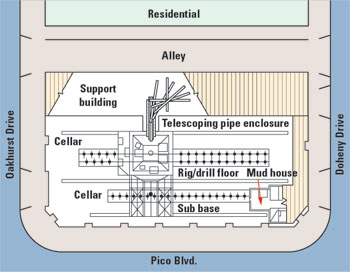 |
Fig. 1. Site plan showing well cellars, rig, support buildings; telescoping pipe handler enclosure, and mud plant.
|
|
At the heart of the new facility is the drilling rig with a number of innovative and interesting components. A rack & pinion hoist is used in place of conventional drawworks, wire rope and blocks. A single rack & pinion long-stroke mud pump is used which has four fluid ends with a stroke of 107 in. All major rig equipment is powered by AC motors and drives, with the AC power supplied by the City of Los Angeles. Rig power is connected via a swing arm to plug panels that are located along the perimeter wall of the site. Large amounts of fresh air are circulated through the support building, rig and mud plant and then out the top of the tower. In addition to the telescoping, sound-attenuated pipe-handling enclosure described above, the expanding pipe conveyor folds up and onto the drillfloor for rig moves.
The hoisting system uses an innovative application of rack & pinion R&P technology, new to this type of equipment, Fig. 2, 3. Conventional drawworks, and block and tackle hoists, have been used for drilling and workover since the turn of the 20th century. Drawworks, which squeal and squeak as the brakes are frequently applied/ released during hoisting and drilling operations, are the main reason BreitBurn chose to purchase the new R&P technology. The R&P system, driven by AC motors, eliminates the drawworks and noisy brakes. Application of R&P technology to drilling operations was developed by EDM in Norway. This is the first such application in the US and the first operational rig in the world used for oil and gas operations.
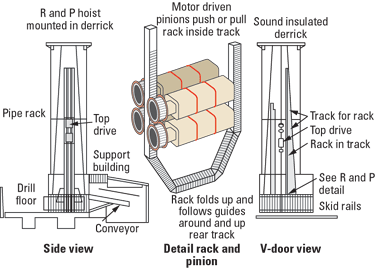 |
Fig. 2. Schematic elevation views of lower end of rack & pinion hoist.
|
|
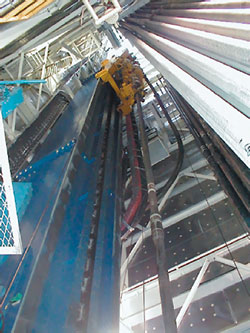 |
Fig. 3. Front view of rack & pinion hoist, looking up.
|
|
The combination of the R&P hoist and its AC motors/ drives represents a drilling system applicable to all types of drilling rigs. The demonstrated advantages are:
- Ease of operation – The joystick that controls the R&P hoist is easy to operate. The sensitivity of torque needed to pull pipe can be set at the console. Since the rig is used as both a drilling and workover rig, the torque control is adjusted to an acceptable pulling force for each of the various types of drill pipe and tubing. Drillers can safely learn its operation in a very short period of time.
- Precise control/movement – Movements of fractions of an inch can easily be achieved. The controls, plus not hanging on the wire rope drilling line, make this possible. This precise control improves drilling, even more so in directional drilling, underbalanced drilling, workover and fishing operations.
- Pull or push load – The advantage of being able to push a load has many applications. An immediate application is a reduction in the number of heavyweight drill collars needed to start drilling. The push capabilities of the rig are 130,000 pounds of force.
- Accurate load indicator – The load cell system, along with an analog screen display, have shown to be more accurate than conventional drawwork systems.
- No wire-rope drilling line – The problems of dealing with wire-rope drilling line are eliminated, plus the R&P has a projected life (via testing) in excess of 20 years.
The R&P technologies developed by EDM have three applications at the West Pico Drillsite. First, EDM developed all-electric R&P technology in the late ’90s, with the objective of building a lightweight, portable, safe and environmentally friendly rig to change how future drilling operations are carried out. A prototype was designed and built for testing in Norway. Det Norske Veritas tested the equipment for months and reported it suitable for drilling operations. The 1,200 HP R&P hoist is designed to pull to 250 tons or push to 65 tons. The hoist structure is designed in this application for doubles, two joints of pipe to a stand. The structure is made up of three sections which are bolted together as the rig is assembled.
Second, EDM developed the first of its kind R&P long-stroke mud pump to be used for drilling and workover operations, Fig. 4. The R&P mud pump stroke is almost nine feet, compared to something less than one foot with the conventional short-stroke pumps used for the last 70 years. The long-stroke pump vibrates much less than a conventional mud pump. The number of strokes required for pumping operations is about one tenth those of other mud pumps used today. The low number of strokes required for the desired output will result in less maintenance and downtime of the equipment. The B800 HP R&P mud pump is designed to operate at up to 400 gpm and 2,800 psi with 8-in. liners, and 220 gpm and 5,300 psi with 6-in. liners. The unique design of the pump has allowed 24-hr-a-day operation, without disturbing the local community.
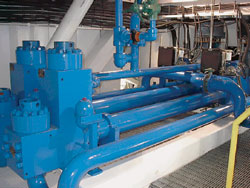 |
Fig. 4. EOM long-stroke mud pump located in the sub-base below the drillfloor.
|
|
Third, R&P technologies are incorporated in the top drive. This top drive is similar in operation to other top drives on the market, except that it needs to rotate 90° to pick up or lay down drill pipe/ casing from the V-door conveyor. The Gould Bass rubberized conveyor quickly and quietly transfers drilling equipment from the support building to the drillfloor.
The AC drive system and MCC house were provided by IDM/OMRON. The variable speed controllers, AC drives, operate the direct drive drilling equipment, i.e., R&P hoist, top drive and mud pumps. This is a change from the DC motors normally used in oilfield operations and, besides the advantages of AC drives/ motors, it reduced space requirements significantly.
Noise reduction is a key area of concern due to the location, Fig. 5. Noise reduction coefficients (NRC) of 0.7 were required in the buildings and sound transmission class numbers (STC) of 35 to 42 were required, depending on the location on the site. Where possible, buildings are constructed using 1-ft-thick masonry blocks and concrete. In other areas, the walls are made out of sound panels designed for the required prevention of sound transmission from the site. The city requirement of a 65 dB sound level is monitored/ recorded continuously with an audio-video system.
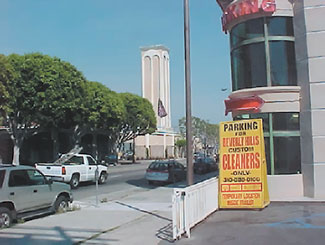 |
Fig. 5. Drill site (tall building) is in an urban setting.
|
|
Heating, ventilation and air conditioning concerns were addressed for each distinct area of operation at the site. Air is forced into the support building at 40,000 cfm, which provides a safe working environment for the primary delivery area, as well as where general operations are carried out daily. The onsite transformer and the mud plant areas are also equipped with forced-air ventilation. The fans and ducting are acoustically lined to mitigate any noise from the site. The derrick structure is equipped with a dual ventilation system that supplies both fresh air to the equipment located within the structure and forced air for cooling and a safe working environment.
Production wellwork operations began with the rig at the site in October of 2002. Each of the different types of production lift has been at work since the rig started operations. The two main lift types used at the West Pico site are hydraulic lift and ESP lift. A third type of lift is hydraulic actuated rod pumps. Two- and three-string hydraulic wells have been pulled and re-run. Several ESP wells have been pulled and re-run. Additional wells have been converted to rod pump wells. Injection-well work has also been done with the new rig. Production operations are carried out between the drilling of new wells.
RIG STARTS DRILLING
Drilling operations began in December 2002. Five-inch drill pipe is used. Each of the wells drilled thus far consists of abandoning the old well with cement in zone and above the top of the shallowest productive zone in the area; then cutting and recovering the main string of casing, usually 8-5/8 in., just below the 13-3/8-in. surface-casing shoe. Once the casing is recovered, a cement kickoff plug is placed in the openhole and used to re-drill the well to a new bottomhole location. The wells are completed by running pairs of 30-ft lengths of casing due to the constraints of having to turn the casing inside of the support building up to the rig floor via the conveyor system. After cementing the casing, the well is tubing-conveyed perforated. The production system is then placed in the well and the well is put on production.
The West Pico Modernization Project proves that with ingenuity, planning, cooperation and the innovative application of new technologies, oil-producing operations can be improved and continued in an environment not thought possible. Well operations will continue at the site for many years to come with minimal impact on the neighborhood.
Production is expected to peak at nearly one million barrels of oil per year, compared to current production of 300,000 barrels per year. The modernization vastly improved the way operations are carried out compared to past practices. The use of all-electric drilling and wellwork equipment has removed the old diesel pollutants and associated noise from the neighborhood. The use of new R&P technologies, with sound enclosures and construction requirements, has reduced the amount of noise generated. Well activities are carried out with little or no impact on the surrounding community.
To publicize the success of this project, the Los Angeles chapter of SPE nominated the BreitBurn West Pico Modernization Project for the Los Angeles Council for Engineers and Scientists (LACES) Project Achievement Award. The Award was presented in conjunction with National Engineers Week – at the Institute for the Advancement of Engineer’s (IAE) annual awards banquet – to BreitBurn for the modernization of the West Pico drillsite. 
ACKNOWLEDGMENTS
The authors thank Tetra Design for the architecture and design work, W. E. O’Neil Construction Co. for the general contracting work, Voorhees Rig International for the rig installation, EDM for the innovative rack & pinion technology, Gould Bass for their work on the conveyor system and pipehandling enclosure; and IDM/Omron for work on the AC control house.
THE AUTHORS
|
 |
Steve Liles, a petroleum industry consultant, formerly with Brietburn, is a PE graduate from the University of Oklahoma. He also has an MBA from California State University Long Beach. He worked as a drilling engineer, worked in production operations, was the chief engineer of field services, and was an area superintendent during a 15-year span with Thums Long Beach Co. before joining BreitBurn in 1998, where responsibilities included managing two drillsites and other production facilities in Southern California. He was project manager for the West Pico Modernization Project.
|
 |
Ron Tinkham is president of Tinkham Inc., a design and engineering company serving the oil field, specializing in drilling rig design. His area of rig expertise includes rig layouts, wheeled rigs, quick-moving rigs, rigs for all parts of the world including the Arctic, swamps and the desert. His more than 20 years’ experience started at Santa Fe Drilling as manager of land rigs. He consults throughout the world and has designed and/or modified rigs too numerous to count. He patented the Hover/ Jackup Land Rig for the Arctic, which is under development. He holds a BSME from NIT in California.
|
 |
Jens P. Røkenes is one of the cofounders of EDM, and serves as the company’s managing director. He has more than 20 years’ experience in operation, maintenance, modification and newbuilds of drilling modules. He previously worked in completion and construction management for companies such as Hitec Dreco, Hitec and Transocean.
|
 |
Bjørn Eilertsen is the other cofounder of EDM, where he serves as technical manager and board member. He has nearly 30 years’ oilfield experience. He is the founder of several patented systems: Starracker pipehandling system, R&P rig with heave compensation, Mud Pumps, Fingerboard, and more.
|
|











